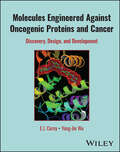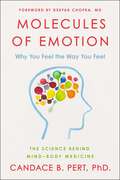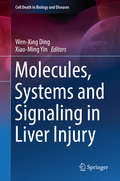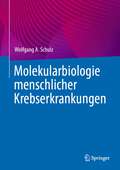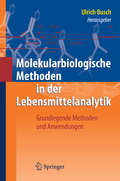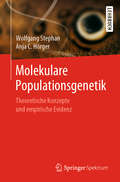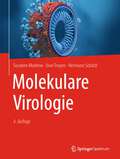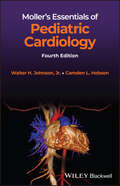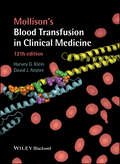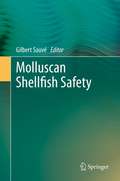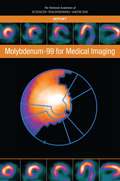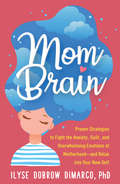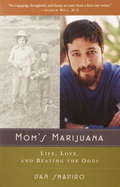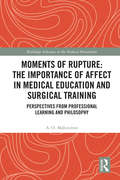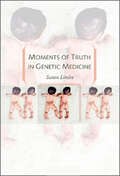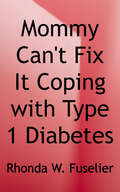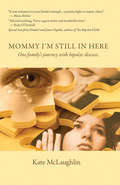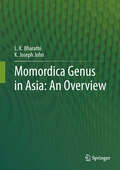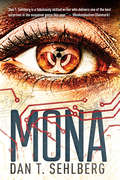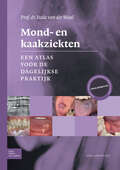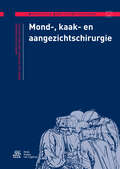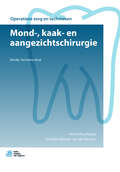- Table View
- List View
Molecules Engineered Against Oncogenic Proteins and Cancer: Discovery, Design, and Development
by E. J. Corey Yong-Jin WuMolecules Engineered Against Oncogenic Proteins and Cancer A comprehensive review of the latest molecular advances in cancer treatment Featuring 91 total small molecule kinase/KRAS inhibitors, 80 of which are FDA-approved, Molecules Engineered Against Oncogenic Proteins and Cancer documents the recent scientific advances that have transformed one of medicine’s most challenging areas—cancer treatment. Most of these inhibitors specifically block oncogene-induced carcinogenic proteins with results that have dramatically advanced the treatment of cancer. In addition, the structural formulas of more than 100 kinase/KRAS inhibitors in clinical trials are presented. With a very well-known chemist as an author, Molecules Engineered Against Oncogenic Proteins and Cancer includes information on: Each molecule’s structure, function of the kinase target and relevance to cancer, the drug discovery process, and molecular details of drug action Mutated protein kinases as oncoproteins and targets for inhibition, along with the details of discovery for each antitumor antikinase agent History of oncoprotein inhibitors and their role in advancing the treatment and understanding of cancer The discovery process as a whole, effective strategies for innovation, ongoing challenges, and a glimpse of the future of the field Combining the most significant recent discoveries in a unique and useful way, Molecules Engineered Against Oncogenic Proteins and Cancer is an essential resource for researchers and students in bioscience, medicine, chemistry, and oncology as well as for those at industrial companies involved in therapeutic discovery.
Molecules of Emotion: The Science Behind Mind-Body Medicine
by Candace B. PertThe bestselling and revolutionary book that serves as a &“landmark in our understanding of the mind-body connection&” (Deepak Chopra, MD).Why do we feel the way we feel? How do our thoughts and emotions affect our health? In her groundbreaking book Molecules of Emotion, Candace Pert—an extraordinary neuroscientist who played a pivotal role in the discovery of the opiate receptor—provides startling and decisive answers to these and other challenging questions that scientists and philosophers have pondered for centuries. Pert&’s pioneering research on how the chemicals inside our bodies form a dynamic information network, linking mind and body, is not only provocative, it is revolutionary. By establishing the biomolecular basis for our emotions and explaining these scientific developments in a clear and accessible way, Pert empowers us to understand ourselves, our feelings, and the connection between our minds and our bodies—or bodyminds—in ways we could never possibly have imagined before. From explaining the scientific basis of popular wisdom about phenomena such as "gut feelings" to making comprehensible recent breakthroughs in cancer and AIDS research, Pert provides us with an intellectual adventure of the highest order. Molecules of Emotion is a landmark work, full of insight and wisdom and possessing that rare power to change the way we see the world and ourselves.
Molecules, Systems and Signaling in Liver Injury
by Xiao-Ming Yin Wen-Xing DingThis essential volume presents comprehensive information on cell death and autophagy in liver diseases, including the role and molecular signaling pathways of cell death in alcohol and non-alcoholic fatty liver disease, bile acids, hepatitis C virus and drug-induced liver injury. The book starts with a discussion of lipotoxicity in non-parenchymal cells, followed by a discussion of cell death and autophagy in cholangiocytes, hepatic stellate cells and Kupffer cells in hepatic biliary diseases, fibrosis and liver inflammation. The book also covers Bcl-2 family proteins, beta-catenin and HMGB1 signaling in regulating cell death in the liver as well as mitochondria, ER stress and gut microbiota on liver injury. The Cell Death in Biology and Diseases series has recruited world experts ranging from basic scientists to clinicians on cell death in liver diseases. Likewise the contributors of this volume are leaders in their fields with worldwide expertise and perspective. Molecules, Systems and Signaling in Liver Injury is an essential companion to Hepatocytes and Non-Parenchymal Cells and Diseases. It is beneficial for both clinicians and basic scientists and is relevant to those working on drug discovery for preventing and treating liver diseases by targeting cell death and autophagy pathways.
Molekularbiologie menschlicher Krebserkrankungen
by Wolfgang A. SchulzDieses Lehrbuch beschreibt die wichtigsten molekularen und biologischen Prozesse bei menschlichen Krebserkrankungen und wie sie zur Entstehung und zum Fortschreiten verschiedener Krebsarten beitragen. Darauf aufbauend wird dargestellt wie Erkenntnisse aus der molekularen Krebsforschung zur Verbesserung der Krebsprävention, -diagnostik und -behandlung genutzt werden können.Teil I des Lehrbuchs fasst das aktuelle Grundlagenwissen über die Eigenschaften bösartiger Tumoren, die Ursachen von Krebserkrankungen, Krebsgenetik, -genomik und -epigenetik zusammen und stellt die wichtigsten genetischen, molekularen und zellulären Mechanismen der Krebsentstehung vor. Im zentralen Teil II wird ausführlicher dargelegt, wie diese Mechanismen bei einzelnen Krebserkrankungen des Menschen in vielfältiger Weise zum Tragen kommen. In Teil III wird beschrieben, wie Erkenntnisse aus der molekularen Krebsforschung für eine verbesserte Prävention, Diagnostik und Therapie genutzt werden.Diese Neuauflage wurde umfassend überarbeitet und enthält insbesondere aktualisierte Informationen über Krebsgenomik, Epigenetik, virale Karzinogenese, Krebsdiagnostik und Krebstherapie sowie ein neues Kapitel über Lungenkrebs.Krebsforschung ist mehr denn je ein interdisziplinäres Unterfangen, das ein Grundwissen über die gängigen Begriffe, Fakten und Konzepte erfordert. Dieses Buches soll fortgeschrittenen Studierenden und Praktikern verschiedener Disziplinen diese Grundlagen vermitteln und so die Lücke zwischen den Standardlehrbüchern der Molekularbiologie und Pathologie und der spezialisierten Krebsliteratur schließen. Die Übersetzung aus dem Englischen wurde mit Hilfe von künstlicher Intelligenz durchgeführt und vom Autor vor allem auf inhaltliche Korrektheit hin durchgesehen.
Molekularbiologische Methoden in der Lebensmittelanalytik
by Ulrich BuschMolekularbiologische Verfahren werden seit Längerem in der Analytik von Lebensmitteln, Saatgut und Futtermitteln angewendet. Das Spektrum reicht vom Nachweis gentechnisch veränderter und allergener Inhaltsstoffe über die Tierartendifferenzierung in Fleischprodukten bis zur Bestimmung pathogener Keime. Das Buch vermittelt in äußerst praxisbezogener Weise die notwendigen molekularbiologischen Techniken und das nötige Hintergrundwissen. Einen Schwerpunkt bildet die Polymerase-Kettenreaktion (PCR), einschließlich Realtime-PCR und Qualitätssicherung.
Molekulare Populationsgenetik: Theoretische Konzepte und empirische Evidenz
by Wolfgang Stephan Anja C. HörgerDas Buch behandelt die genetische Vielfalt von Populationen von Organismen. Es erläutert, wie genetische Vielfalt gemessen wird und wie aus diesen Daten die Mechanismen untersucht werden können, die die Variabilität auf der Genomebene und damit die Mikroevolution einer Population beeinflussen. Ziel dieses Buches ist es, das Wirken der natürlichen Selektion im Genom zu verstehen und vom Einfluss neutraler Evolutionskräfte (wie genetischer Drift, Mutation und Rekombination) unterscheiden zu lernen. Dazu werden die grundlegenden theoretischen Konzepte der Populationsgenetik eingeführt und anhand von zahlreichen Beispielen aus allen Organismengruppen (Menschen, Tieren, Pflanzen und Mikroorganismen) veranschaulicht. Um das Verständnis der theoretischen Ableitungen von Hypothesen und der darauf basierenden Datenanalysen zu überprüfen und weiter zu vertiefen, schließt jedes Kapitel mit Übungsaufgaben und Lösungen ab.
Molekulare Virologie
by Hermann Schätzl Susanne Modrow Uwe TruyenDieses bewährte Standardwerk vermittelt einen ausgewogenen Überblick über die bekannten humanpathogenen und tierpathogenen Viren, wie beispielsweise Papilloma- und Influenzaviren und wurde ergänzt um die eher neu aufgetretenen Viren, insbesondere Zikavirus, das neuartigen Coronavirus SARS-CoV-2 und das Schmallenberg-Virus, einem Bunyavirus, das Rinder, Schafe und Ziegen infiziert.Der erste Teil des Buches präsentiert die allgemeinen Prinzipien der Struktur, Vermehrung und Lebenszyklen von Viren und beschreibt die wichtigsten pathogenetischen und immunologischen Mechanismen viraler Erkrankungen. Auch die Diagnostik und Therapie sowie die Epidemiologie solcher Infektionen und das heutige Methodenrepertoire der Virologen werden hier vorgestellt.Der zweite, spezielle Teil führt systematisch durch die Vielfalt der human- und tierpathogenen Viren. Ausführlich dargestellt sind hier Morphologie, Genomorganisation, Proteinausstattung sowie Replikationsmechanismen der verschiedenen Virusfamilien. Für die jeweils wichtigsten Vertreter liefern die Autoren einen Überblick über die relevanten humanmedizinisch-klinischen beziehungsweise veterinärmedizinischen Aspekte. Auch seuchenrechtliche Fragen kommen hier zur Sprache.Das Lehrbuch dient seit vielen Jahren als bewährte Einführung in die molekular- und zellbiologischen Grundlagen der Virologie und ist unentbehrlich für Fachleute und Studierende. Die 4. Auflage wurde ergänzt mit den aktuellen Daten zu den jeweiligen Viren und bietet somit einen aktuellen Überblick zu den Replikationsstrategien und verbindet diese mit der Pathogenese der Erreger. Integriert wurden Virusspezies, die während der vergangenen Jahre neu aufgetreten sind und in vieler Hinsicht die öffentliche Diskussion beherrscht haben. Nicht zuletzt zählen hierzu die Infektionen des Menschen mit dem neuartigen Coronavirus SARS-CoV-2, dem Zikavirus, den tier- wie humanpathogenen Bornaviren sowie dem Schmallenberg-Virus, dessen Infektion bei Wiederkäuern schwere Fetopathien verursacht. Mit seiner klaren Gliederung und verständlichen Darstellung weist dieses systematisch angelegte Lehr- und Nachschlagewerk• Studierenden und Lehrenden in Biowissenschaften, Human- und Veterinärmedizin• Virologen, forschungsorientierten Klinikern, Tierärzten und Seuchenmedizinern sowie• Fachleuten in Mikrobiologie, Hygiene und Diagnostikden Weg durch die Vielfalt der virologischen Forschungsergebnisse.
Moller's Essentials of Pediatric Cardiology
by Walter H. Johnson Camden L. HebsonHighly useful guide for all members of a multidisciplinary team managing children suffering from heart disease Built on the success of previous editions and brought to you by a stellar author team, Moller’s Essentials of Pediatric Cardiology, 4th Edition provides a unique, concise, and extremely practical overview of heart disease in children. From history-taking, physical examination, ECG, and chest X-ray—the basics that enable clinicians to uncover possible problems and eliminate areas of false concern—this work goes on to examine the range of more complex topics in the diagnosis and treatment/management of childhood cardiovascular disease. Every chapter is fully updated with the very latest clinical guidelines and management options from the AHA, ACC, and ESC. Recent updates also include an enhanced section on imaging, including recent advances in cardiac MRI and fetal echocardiography, new techniques in genetic testing for heart disease in special populations, and much more emphasis on the importance of echocardiography in understanding the pathophysiology of congenital cardiac malformations. This work also includes an expanded section on cardiac conditions in the neonate, specifically on prenatal diagnosis and management, and neonatal screening for congenital heart disease. Moller’s Essentials of Pediatric Cardiology, 4th Edition also provides: Tools to diagnose cardiac conditions in children and environmental and genetic conditions associated with heart disease in children Anomalies with a left-to-right shunt in children, conditions obstructing blood flow in children, and congenital heart disease with a right-to-left shunt in children Unusual forms of congenital heart disease in children, unique cardiac conditions in newborn infants, and the cardiac conditions acquired during childhood Abnormalities of heart rate and conduction in children and congestive heart failure in infants and children Moller’s Essentials of Pediatric Cardiology, 4th Edition is a succinct and accessible yet highly detailed and informative resource for treating children suffering from heart disease. It is an invaluable reference for anyone working on a multidisciplinary team treating patients with these attributes.
Mollison's Blood Transfusion in Clinical Medicine
by David J. Anstee Harvey G. KleinMollison's Blood Transfusion in Clinical Medicine is an icon in the field of transfusion and the first edition was published in 1951. The book arose from the concept of the transfusionist, as both scientist and expert consultant. For many years, this text has provided the primary, and often the sole, reference for detailed information and practical experience in blood transfusion. The book is completely revised and updated throughout to include the latest advances and developments in the field.
Molluscan Shellfish Safety
by Gilbert SauvéIn a time of rapid climatic, industrial and technological changes in molluscan shellfish producing and exporting regions, it is of the utmost importance to keep a keen eye on developing trends. This collection of recent research in molluscan shellfish safety, risk assessment, risk management, regulation and analytical methods presented at the 8th ICMSS (International Conference on Molluscan Shellfish Safety) offers valuable insights in the latest scientific findings.
Molybdenum-99 for Medical Imaging
by Engineering Medicine National Academies of SciencesThe decay product of the medical isotope molybdenum-99 (Mo-99), technetium-99m (Tc-99m), and associated medical isotopes iodine-131 (I-131) and xenon-133 (Xe-133) are used worldwide for medical diagnostic imaging or therapy. The United States consumes about half of the world’s supply of Mo-99, but there has been no domestic (i.e., U.S.-based) production of this isotope since the late 1980s. The United States imports Mo-99 for domestic use from Australia, Canada, Europe, and South Africa. Mo-99 and Tc-99m cannot be stockpiled for use because of their short half-lives. Consequently, they must be routinely produced and delivered to medical imaging centers. Almost all Mo-99 for medical use is produced by irradiating highly enriched uranium (HEU) targets in research reactors, several of which are over 50 years old and are approaching the end of their operating lives. Unanticipated and extended shutdowns of some of these old reactors have resulted in severe Mo-99 supply shortages in the United States and other countries. Some of these shortages have disrupted the delivery of medical care. Molybdenum-99 for Medical Imaging examines the production and utilization of Mo-99 and associated medical isotopes, and provides recommendations for medical use.
Mom Brain: Proven Strategies to Fight the Anxiety, Guilt, and Overwhelming Emotions of Motherhood—and Relax into Your New Self
by Ilyse Dobrow DiMarcoHave you had a &“mom brain&” moment? Your heart is racing, your palms are sweaty, and your mind is spinning with anxiety, self-doubt, and whether or not you remembered to pack the diaper cream. Becoming a mother is a joyful rite of passage, but it can also be overwhelming--physically and emotionally. How can you calm the worries, quiet the guilt, and be present with yourself and your kids? Psychologist and mom Ilyse Dobrow DiMarco specializes in the myriad issues that women with young children struggle with. In this compassionate guide, she shares science-based strategies to help you cope with common challenges and make peace with your transformed identity. Dr. Dobrow DiMarco uses frank, funny, and moving stories to illustrate ways to tame self-critical thoughts and navigate the "new normal" of work, marriage, and friendships. Learn how you can mindfully accept the highs and lows of parenting--even in the toughest moments.
Mom's Marijuana
by Dan ShapiroA young man battles Hodgkin's disease and survives--with more than a little help from his Mom--in this wry and uplifting memoir about life, love, and beating the odds.When Dan Shapiro's decidely anti-drug mom put aside her convictions and grew marijuana in her backyard garden (behind a discrete screen of sunflowers), he learned that in the face of a crisis we all have the opportunity to decide what is most important to us. In this hilarious, high-spirited, sometimes harrowing memoir, Shapiro invites us into his battle with cancer, his romance with an oncology nurse, his journey through graduate school, and his most important life lessons. He tells his story with wit and grace and indomitable spirit, showing us that only when the rhythm of life is stirred violently are able to discover its full beauty.From the Trade Paperback edition.
Moments of Rupture: Perspectives from Professional Learning and Philosophy (Routledge Advances in the Medical Humanities)
by A. O. MahendranSurgery is a craft specialty: ‘doing’ in response to what is seen, felt and anticipated. The potent odours and the raw images of flesh, elicit strong sensations and responses in the here-and-now or ‘thisness’ (haecceities) of practice. These experiences, trigger a world of affects and senses that can disturb or rupture familiar or established ways of thinking and knowing. This book attempts to articulate these emotional complexities of learning and practice by exploring affective encounters with the uncertainty of medical events. Employing a practice based inquiry, grounded in philosophical notions of affect and related concepts, real stories of actual practice are analysed and theorised to examine how events of clinical practice come to matter or become meaningful to surgeons, potentially disclosing new or modified capacities to see, think, understand and act. The philosophical writings of Alfred North Whitehead, Gilles Deleuze, Gilbert Simondon and Brian Massumi inform the exploration. The critical discussions of this book are relevant for healthcare professionals, medical educators, practitioners and researchers interested in its main exploration: the affective conditions that emerge from disturbances in practice and their power to shape, construct and transform how professionals understand their practice and function within it.
Moments of Truth in Genetic Medicine
by M. Susan LindeeGenetic research increasingly dominates medical thought and practice in the United States and in many other industrialized nations. Susan Lindee's original study explores the institutions, disciplines, and ideas that initiated the reconfiguration of genetic medicine from a marginal field in the mid-1950s to a core research frontier of biomedicine. Tracing the work of geneticists and other experts in identifying and classifying disease during the explosive period between 1950 and 1980, Lindee identifies the individual "moments of truth" that moved the field away from its eugenic past to the center of a new world view in which nearly all disease is understood to be fundamentally genetic. She suggests that these moments of truth were experienced not only by scientists but also by those who had familial, intimate, emotional knowledge of hereditary disease: patients, family members, and research subjects. Focusing on benchmarks in the field—such as the rise of neonatal testing in the 1960s, genetic studies of unique human populations such as the Amish, the development of human cytogenetics and human behavioral genetics, and the efforts to find genes for rare diseases such as familial dysautonomia—she tracks the emergence of a biomedical consensus that nearly all disease is genetic disease. Using the success of this field as a point of entry, Lindee chronicles both the production of knowledge in biomedicine and changes in the cultural meaning of the body in the late twentieth century. She suggests that scientific knowledge is a community project that is shaped directly by people in many different social and professional locations. The power to experience and report scientific truth may be much more dispersed than it sometimes appears, because people know things about their own bodies, and their knowledge has often been incorporated into the technical infrastructure of genomic medicine. Lindee's pathbreaking study shows the interdependence of technical and social parameters in contemporary biomedicine.
Mommies, Daddies, Donors, Surrogates
by Diane EhrensaftIf you need help having a baby, reproductive technology can supply the answer. But it also raises a host of questions that won't arise until after the child is born What will you say to "Where did I come from?" when the answer includes a donor or surrogate? Will knowing the truth about how you conceived make your child love you less? Will having a baby with someone else strain your relationship with your spouse or partner? What will grandparents, family members, friends, and coworkers think? Dr. Diane Ehrensaft--a developmental and clinical psychologist who's worked with families formed using assisted reproductive technology for more than 20 years--helps you anticipate the big questions and find solutions that are right for you and your loved ones. Dr. Ehrensaft offers information, support, and straightforward advice for coping with private worries, confronting public prejudices, and raising happy, healthy children. Single or married, straight or gay, anyone looking forward to the joys and challenges of building a family with the help of a donor or surrogate will discover a wealth of thought-provoking ideas and fresh insights in this sensitive, practical, and positive book.
Mommy Can't Fix It: Coping With Type One Diabetes
by Rhonda W. FuselierReceiving a diagnosis for an incurable disease is difficult for a parent. Having a child diagnosed with Type One Diabetes hurls a mother onto a roller-coaster of emotions. Read one mother's story into learning, growing and accepting the diagnosis of Type One Diabetes for her sons.
Mommy I'm Still In Here
by Kate MclaughlinMommy I'm Still In Here clarifies myths and misunderstandings about bipolar disorder through the lives of Kate McLaughlin's two teenaged children and provides vital information to a public frequently misled by sensationalist media and inaccurate Hollywood portrayals. This book supports, educates, and informs the reader, offering hope and encouragement.
Momordica genus in Asia - An Overview
by L. K. Bharathi K Joseph JohnAsiatic Momordica comprises 10 species of which 3 are monoecious and rest dioecious. They are unique in the sense that all are wild or cultivated vegetables with medicinal uses. Barring bitter gourd, all are under utilized vegetables with little research and conservation efforts. In this book, the authors have presented the available information on various aspects of Asiatic Momordica like taxonomy, cytogenetics, crop improvement, origin, ethnobotany and crop production at one place. The book is well illustrated with color maps and photographs depicting habit, morphology and distribution of individual taxa. Species distribution map for all Indian taxa, descriptor for characterization and preliminary evaluation of dioecious and monoecious group available varieties, keys for botanical identification are some of the unique features of the book. The book will be useful to botanists, horticulturists, foresters, environment educators, conservation biologists, plant science students in general and all interested in agrobiodiversity.
Mona
by Dan SehlbergA suspenseful and highly original technothriller based on breathtaking developments in the field of thought-controlled systems and cyber warfare.Eric Söderqvist, professor of computer science at the Royal Institute of Technology in Stockholm, has invented Mind Surf: a thought-controlled system that allows people with disabilities to browse the web.Samir Mustaf is a former MIT professor whose daughter Mona was killed by an Israeli cluster bomb five years earlier. He has just developed the most sophisticated computer virus the world has ever seen, for the purpose of a cyber attack against Israel’s financial system.Eric’s wife Hanna falls into a coma — struck by an aggressive and previously unknown virus — after having tested her husband’s invention. The doctors are at a loss. Although everyone around him thinks he’s gone mad, Eric is convinced that his wife has been infected by a powerful computer virus known as Mona, and that the only way he can save her is by tracking down its creator.
Mond- en kaakziekten
by I. van der WaalTweede, herziene versie van de atlas Mond- en kaakziekten van prof. dr. Isaac van der Waal
Mond- en kaakziekten
by I. van der WaalDit boek geeft een praktijkgericht overzicht van de pathologie van het mondgebied. Het beschrijft kernachtig de aandoeningen in en rond de mond. Deze aandoeningen komen voor op het mondslijmvlies, de speekselklieren, in het kaakbot, op de tong, het gehemelte en de lippen. Het boek bevat veel duidelijke afbeeldingen. In deze vierde druk van Mond- en kaakziekten zijn actuele bevindingen uit de literatuur en ervaringen van de auteur verwerkt in praktijkgerichte adviezen. Tevens zijn nieuwe afbeeldingen toegevoegd. De inleiding van het boek gaat in op het mondonderzoek, de proefexcisie en de verwijzingsprocedure. Vervolgens worden de meest voorkomende aandoeningen beschreven. Nieuw is dat de toegang tot patiënteninformatie. Van een aantal in het boek beschreven aandoeningen is een patiëntenversie geschreven. Via de bij het boek behorende website kunnen deze geprint worden en aan de patient worden meegegeven.Deze atlas is met name bestemd voor tandartsen. De inhoud is echter ook van belang voor andere zorgprofessionals die betrokken zijn bij diagnostiek en behandeling van afwijkingen in en rond de mond, zoals huisartsen, mondhygiënisten en medisch specialisten.
Mond-, kaak- en aangezichtschirurgie (Operatieve Zorg En Technieken Ser.)
by Annelies Detmar-van Meulen Arris SchuurkampHet leerboek 'Mond-, kaak- en aangezichtschirurgie' is een helder geschreven boek dat op overzichtelijke wijze de meest gangbare, in de mond-, kaak en aangezichtschirurgie voorkomende operaties beschrijft. Het leerboek bestaat uit zeven hoofdstukken. Elk hoofdstuk begint met een inleiding waarin wordt ingegaan op de achtergronden van de in dat hoofdstuk beschreven operaties.
Mond-, kaak- en aangezichtschirurgie (Operatieve zorg en technieken)
by Arris Schuurkamp Annelies Detmar-van der MeulenHet leerboek Mond-, kaak- en aangezichtschirurgie is een helder geschreven boek dat op overzichtelijke wijze de meest gangbare, in de mond-, kaak-en aangezichtschirurgie voorkomende operaties beschrijft. Het leerboek bestaat uit zeven hoofdstukken. Elk hoofdstuk begint met een inleiding waarin wordt ingegaan op de achtergronden van de in dat hoofdstuk beschreven operaties. Hoofdstuk 1 behandelt de operaties aan of gerelateerd aan het gebit. Hoofdstuk 2 gaat over fracturen en hoofdstuk 3 over kaakstandcorrecties. In hoofdstuk 4 komen de operaties aan het kaakgewricht aan bod en in hoofdstuk 5 de preprothetische chirurgie en implantologie. Hoofdstuk 6 beschrijft de meest voorkomende oncologische operaties in de kaakchirurgie. Tot slot wordt in hoofdstuk 7 een aantal operaties beschreven die niet onder een van de voornoemde onderwerpen vallen.Mond-, kaak- en aangezichtschirurgie is bedoeld als leerboek voor operatieassistenten in opleiding en als leerboek en naslagwerk voor gediplomeerde operatieassistenten. De reeks ‘Operatieve Zorg en Technieken’ is bestemd voor de opleiding tot operatieassistent. Naast het basisboek bestaat de reeks uit een aantal vervolgdelen, waarin de verschillende specialismen van de chirurgie worden behandeld. Elk deel in de reeks heeft dezelfde indeling. Ieder hoofdstuk begint met een inleiding, gevolgd door een uitwerking van de pre-, per- en postoperatieve fase van de operatie. Bij alle operatiebeschrijvingen staat een vermelding van de operatie-indicatie en het doel van de operatie. De opstelling van het operatieteam wordt per operatiebeschrijving verduidelijkt door een afbeelding. Achter in het boek wordt altijd een selectie opgenomen van veelvoorkomend specifiek instrumentarium. De reeks ‘Operatieve Zorg en Technieken’ benadert de beroepsuitoefening van de operatieassistent zo dicht mogelijk. De talrijke afbeeldingen onderbouwen deze benadering.
Monday Mornings: A Novel
by Sanjay GuptaEvery time surgeons operate, they're betting their skills are better than the brain tumor, the faulty heart valve, the fractured femur. Sometimes, they're wrong. At Chelsea General, surgeons answer for bad outcomes at the Morbidity and Mortality conference, known as M & M. This extraordinary peek behind the curtain into what is considered the most secretive meeting in all of medicine is the back drop for the entire book.Monday Mornings, by Dr. Sanjay Gupta, follows the lives of five surgeons at Chelsea General as they push the limits of their abilities and confront their personal and professional failings, often in front of their peers at M & M. It is on Monday mornings that reflection and introspection occurs, usually in private. It is Monday Mornings that provides a unique look at the real method in which surgeons learn - through their mistakes. It is Monday Mornings when, if you're lucky, you have a chance at redemption.
